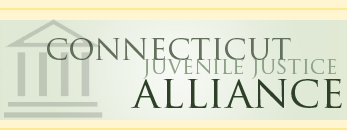 |
 |
|
|
|

|
Confidentiality Statutes of Child Protection Proceedings
|
|
|
In the 2004 General Assembly session, a bill was introduced to open to the public all juvenile proceedings, including cases involving child abuse and neglect. While the bill was not approved, it will be re-introduced in the 2005 Session. To provide context for the discussion, two students at Yale Law School (Michelle Garcia & Charisa Smith), who participate in Yale Legislative Services under the supervision of Voices' Shelley Geballe and Ellen Scalettar, prepared background materials on other states' positions on this issue, including interviews with key stakeholders in states that have opened proceedings in whole, or in part. (November 2004)
|
|
|

|
Alliance Presentation on Bridgeport Detention Center
|
|
|
Alliance Presentation on Bridgeport Detention Center
(186.5K Bytes)
|
|
|

|
Alliance Presentation to Latino and Puerto Rican Affairs Commission
|
|
|
On December 8, 2004, Alliance Executive Director Fernando Mu�iz served as the keynote speaker for the Latino and Puerto Rican Affairs Commission's (LPRAC) annual legislative reception.
(1.88M Bytes)
|
|
|

|
Beyond the Tunnel Problem: Addressing Cross-Cutting Issues that Impact Vulnerable Youth
|
|
|
Call them silos, tunnels, or fragmentation, we know that when a young person has trouble, the kind of services he or she receives has little to do with the underlying needs of that young person and much to do with how they first enter the �system� � school, juvenile justice or child welfare. This means responses are often inappropriate or arbitrary.
This briefing paper, the first in a series sponsored by the Youth Transition Funders Group in partnership with The Annie E. Casey Foundation, identifies some of the challenges and what can be done about them.
|
|
|

|
Child Welfare League of America Juvenile Justice Newsletter - Winter 2005
|
|
|
Check out the latest issue of the Child Welfare League of America's newsletter, "The Link: Connecting Juvenile Justice and Child Welfare."
|
|
|

|
Connecticut Juvenile Crime Rates by County
|
|
|
This file contains juvenile crime rates by county as compiled by the Federal Bureau of Investigation. Data for Fairfield, Hartford and New Haven Counties includes the years 1994 to 2001. Data for other counties only includes data as far back as 1999 because not all data in those counties was reported for 1994 to 1998.
Data reported by the FBI shows that total juvenile crime in Connecticut is down across most indicators and that juvenile crime in the three most populous counties is down considerably since 1994.
(59.74K Bytes)
|
|
|

|
Court Involved Girls in Connecticut, June 2002 Report
|
|
|
From the report's introduction:
"The current study builds upon recent research conducted about juveniles in Connecticut and examines females in this population more closely; it provides more detailed descriptive analyses that may help to explain gender differences and presents information necessary to strengthen services for girls in Connecticut�s Juvenile Justice System.
The information contained in this report will provide policy makers, administrators, and practitioners with:
1. A clearer understanding of the profile of girls in the Connecticut Juvenile Justice system,
2. A greater awareness of how girls enter and emerge from the system in Connecticut in comparison to their male counterparts,
3. Recommendations for culturally sensitive and gender specific programmatic and policy changes to assist in the development and implementation of a short and long term plan to address the needs of girls in the Connecticut Juvenile Justice System."
(1.53M Bytes)
|
|
|

|
CTJJA Strategic Plan
|
|
|
The Strategic Plan of the Connecticut Juvenile Justice Alliance.
(64.62K Bytes)
|
|
|

|
Diverting Children from a Life of Crime: Measuring Costs and Benefits
|
|
|
RAND Corporation report, "Diverting Children from a Life of Crime: Measuring Costs and Benefits"
|
|
|

|
Emily J. Settlement Agreement (June 3, 2005)
|
|
|
New settlement on the Emily J. case. This settlement will provide $8.5 million to help pay for new foster homes, group homes, intense home-based counseling and substance abuse treatment for hundreds of youths, starting in Hartford and expanding statewide in 2006.
(118.46K Bytes)
|
|
|

|
Family With Service Needs (FWSN) Protocol
|
|
|
The joint FWSN protocol between the Court Support Services Division of the Judicial Branch and the Department of Children & Families. The purpose of the protocol is:
- to provide effective diversion from the juvenile justice system;
- to provide speedy and complete access to necessary services.
(3.33M Bytes)
|
|
|

|
Fighting Crime: An Economist's View
|
|
|
Yale economist John Donohue offers his opinoins on policy changes that he believes could reduce crime and dramatically reduce the amount of money spent or lost as a result of crime every year.
|
|
|

|
Improving Conditions for Girls in the Justice System: The Female Detention Project
|
|
|
Summary - The Female Detention Project sought to create a profile of the typical girl in detention. Our goal in doing so was to draw attention to the common needs of girls, to identify gaps in services - both past and present - available to this population, and to identify strategies to compel the system to improve the quality of services offered to girls in Philadelphia's Juvenile Justice System.
|
|
|

|
Justice Cut Short: An Assessment of Access to Counsel and Quality of Representation in Delinquency Proceedings in Ohio
|
|
|
Summary - (released March 13, 2003) This study�the sixth in a series of juvenile defense state assessments by the American Bar Association Juvenile Justice Center�states that the Ohio juvenile justice system suffers from a lack of resources and other systemic barriers. The study also points out that African-American youth appear to be among those who are pushed into the system in largely disproportionate numbers.
To obtain the Virginia, Louisiana, Georgia, Texas or Kentucky reports, visit the ABA Juvenile Justice Center site.
|
|
|

|
Mental Health and Juvenile Justice: Promising Practices in Texas
|
|
|
Published: May 23, 2005
by: Cecilia Garcia
Nationwide, an estimated 20 percent of the young people involved in state juvenile justice systems suffer from severe mental health disorders, according to research cited in Youth and Mental Health Disorders: Issues and Emerging Responses, published in 2000 in the Office of Juvenile Justice and Delinquency Journal.Yet until recently, most juvenile justice systems have paid little attention to the mental health needs of the children and youth with whom they come in contact.
However, there have been some steps towards a more coherent approach. One state that has begun to make progress is Texas.
|
|
|

|
Mental Health Cabinet Report
|
|
|
On December 21, 2004, Lieutenant Governor Kevin Sullivan and the Connecticut Mental Health Cabinet released their final report, including a series of comprehensive proposals designed to significantly improve Connecticut�s failing system of mental health care. The report recommends expanding early intervention, treatment and transition services through Young Adult Services and extending KidCare to add care coordinators, family advocacy services, community collaborative coordinators and flexible emergency funding for children NOT in state custody. As studies of children in Connecticut�s juvenile justice system have shown, at least 50 percent of detained young people to have mental health treatment needs. CTJJA is hopeful that the Mental Health Cabinet recommendations will be implemented and begin to provide services to children who need mental health care before their issues lead them into the juvenile justice system.
|
|
|

|
OJJDP Model Programs Guide
|
|
|
The OJJDP Model Programs Guide is a comprehensive source of information about proven programs to address the entire spectrum of juvenile justice issues from prevention to re-entry. The guide also provide a detailed and easy-to-undersatnd explanation of the juvenile justice system itself and the jargon those within the system tend to use. One of the most useful features is the ability to search the guide's database for sample model programs in any area of interest.
|
|
|

|
Plan for a Continuum of Community Based Services for Adolescent Females Involved in the Juvenile Justice System
|
|
|
Plan for a Continuum of Community Based Services for Adolescent Females Involved in the Juvenile Court System:
IN RESPONSE TO SUBSTITUTE HOUSE BILL No. 5366, SPECIAL ACT No. 04-05
(1.02M Bytes)
|

|

|
Planning Community-Based Facilities for Violent Juvenile Offenders as Part of a System of Graduated Sanctions (OJJDP Report, Aug. 2005)
|
|
|
|
|
|

|
Report on the Reform Initiative at the Connecticut Juvenile Training School
|
|
|
The Report on the Reform Initiative at the Connecticut Juvenile Training School was prepared by the Justice Education Center. It was relased on April 4, 2005 and outlines the reform initiative at CJTS from 2004 to 2005. The report was made possible through the support of the Tow Foundation, JEHT Foundation and Annie E. Casey Foundation.
(1.4M Bytes)
|
|
|

|
Small is Beautiful: Missouri DYS
|
|
|
The Annie E. Casey Foundation's report on the Missouri Division of Youth Services. Over 20 years ago, Missouri closed its large training schools and began to develop a state-wide system of group home-like facilities for its adjudicated youth. The result has been more effective programs, lower recidivism rates and lower costs.
(538K Bytes)
|
|
|

|
Spectrum Associates Report on Disproportionate Minority Contact
|
|
|
In 2001, Spectrum Associates released a report on disproportionate minority contact in Connecticut. The report included a comprehensive look at DMC and a review of 17 recommendations to help Connecticut reduce its rate of DMC.
|
|
|

|
The Dimensions, Pathways and Consequences of Youth Reentry
|
|
|
Youth Reentry publication prepared by the Urban Institute. The nonpartisan Urban Institute publishes studies, reports, and books on timely topics worthy of public consideration.
|
|
|

|
The Role of Behavioral Health Screenings and Assessments in Connecticut's Juvenile Justice System
|
|
|
A recent report released by the Connecticut Center for Effective Practice looks at behavioral health screening and assessment in the juvenile justice system to show how these tools can help children and families to overcome mental health issues and build healthy lives.
|
|
|

|
Troubled Kids, Troubled Courts: A Call to New England�s Juvenile Court Judges and State Policymakers
|
|
|
Summary � (released June 17, 2003) Today the NEJDC released Troubled Kids, Troubled Courts to the public. The report focuses on state levels of support for juvenile court judges: the central players of the juvenile justice system. The report exams five areas affecting juvenile court judges and offers recommendations on reform including on how judicial appointments are made; judges' caseload size; training and education of judges; judicial retention policies; and judges' lack of familiarity with the facilities to which they commit youth and the communities in which youth live.
The report is most critical of states' financial and general support of the juvenile justice systems and for restricting juvenile court judges' ability to participate in advocacy for systemic reform. However, the report also urges juvenile court judges to take steps to increase their understanding of and involvement in the facilities to which they commit youths.
|

|

|
Voice, Choice, Hope Report
|
|
|
Juvenile Justice Reform Consensus Document
(142.61K Bytes)
|

|

|
What Works, Wisconsin: What Science Tells Us About Cost-Effective Programs for Juvenile Delinquency Programs
|
|
|
|


